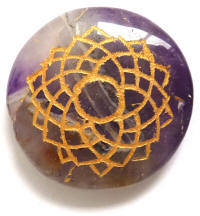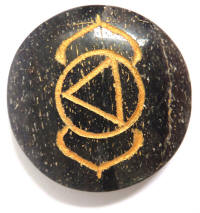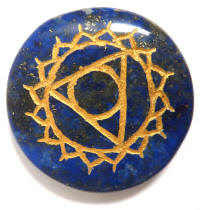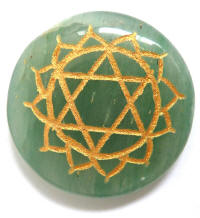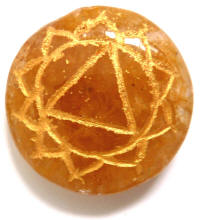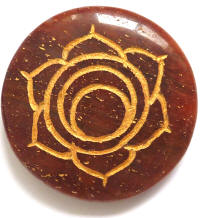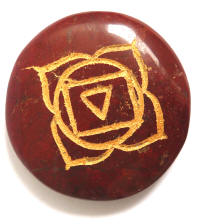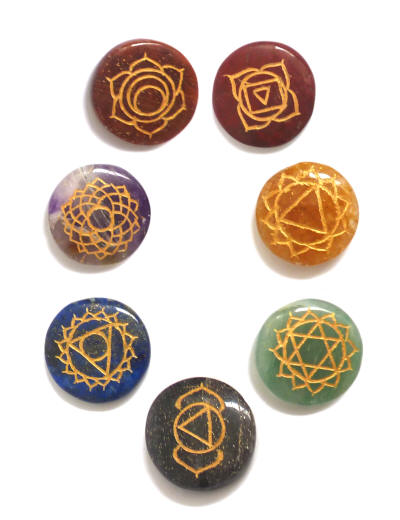








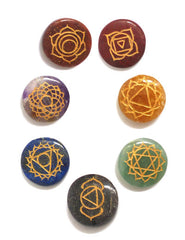
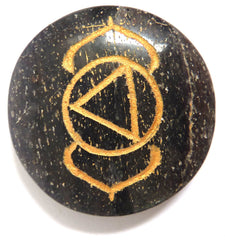
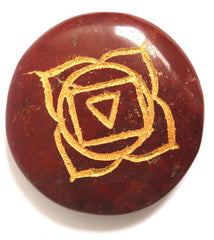
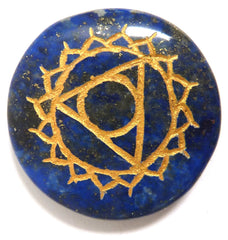





Engraved Chakra Therapy Disc Set
- $29.95 USD
$39.95 USD- $29.95 USD
- Unit price
- per
The Chakra Engraved Gemstone Disk set consists of 7 Large Flat Gemstone Disks, one for each of the 7 Chakras. Each one has the Chakra Symbol Engraved into its Respective Disk. These Disks are ideal for Crystal Healing and Chakra Balancing as they can be placed flat on the body in the corresponding positions shown in the diagram below. This of course is best done lying down with the stones touching your skin for best conduction of vibrations.
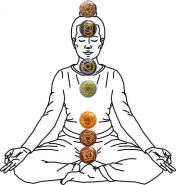
The diagram has been enlarged below so that you can easily identify placement of each of the discs.
The Chakra Symbols and their Associated Meanings |
|
|
|
The Crown Chakra Sahasrara, which means 1000 petalled lotus, is generally considered to be the chakra of pure consciousness, within which there is neither object nor subject. When the female kundalini Shakti energy rises to this point, it unites with the male Shiva energy, and a state of liberating samadhi is attained. Symbolized by a lotus with one thousand multi-colored petals, it is located either at the crown of the head, or above the crown of the head. Sahasrara is represented by the colour white and it involves such issues as inner wisdom and the death of the body.
In Tibetan buddhism, the point at the crown of the head is represented by a white circle, with 32 downward pointing petals. It is of primary importance in the performance of phowa, or consciousness projection after death, in order to obtain rebirth in a Pure Land. Within this chakra is contained the White drop, or Bodhicitta, which is the essence of masculine energy. |
|
|
The Brow Chakra Ajna is symbolized by a lotus with two petals. It is at this point that the two side nadis Ida and Pingala are said to terminate and merge with the central channel Sushumna, signifying the end of duality. The seed syllable for this chakra is the syllable OM, and the presiding deity is Ardhanarishvara, who is a half male, half female Shiva/Shakti. The Shakti goddess of Ajna is called Hakini. Ajna (along with Bindu), is known as the third eye chakra and is linked to the pineal gland which may inform a model of its envisioning. The pineal gland is a light sensitive gland that produces the hormone melatonin which regulates sleep and waking up. Ajna's key issues involve balancing the higher and lower selves and trusting inner guidance. Ajna's inner aspect relates to the access of intuition. Mentally, Ajna deals with visual consciousness. Emotionally, Ajna deals with clarity on an intuitive level. (Note: some believe that the pineal and pituitary glands should be exchanged in their relationship to the Crown and Brow chakras, based on the description in Arthur Avalon's book on kundalini called Serpent Power or empirical research.) In Tibetan Buddhism, this point is actually the end of the central channel, since the central channel rises up from the sexual organ to the crown of the head, and then curves over the head and down to the third eye. While the central channel finishes here, the two side channels continue down to the two nostrils. |
|
|
The Throat Chakra Vishuddha (also Vishuddhi) is depicted as a silver crescent within a white circle, with 16 light or pale blue, or turquoise petals. The seed mantra is Ham, and the residing deity is Panchavaktra shiva, with 5 heads and 4 arms, and the Shakti is Shakini. Vishuddha may be understood as relating to communication and growth through expression. This chakra is paralleled to the thyroid, a gland that is also in the throat and which produces thyroid hormone, responsible for growth and maturation. Physically, Vishuddha governs communication, emotionally it governs independence, mentally it governs fluent thought, and spiritually, it governs a sense of security. In Tibetan buddhism, this chakra has 16 upward pointing petals. It plays an important role in Dream Yoga, the art of lucid dreaming. |
|
|
The Heart Chakra Anahata, or Anahata-puri, or padma-sundara is symbolised by a circular flower with twelve green petals. (See also heartmind.) Within it is a yantra of two intersecting triangles, forming a hexagram, symbolising a union of the male and female. The seed mantra is Yam, the presiding deity is Ishana Rudra Shiva, and the Shakti is Kakini. Anahata is related to the thymus, located in the chest. The thymus is an element of the immune system as well as being part of the endocrine system. It is the site of maturation of the T cells responsible for fending off disease and may be adversely affected by stress. Anahata is related to the colours green or pink. Key issues involving Anahata involve complex emotions, compassion, tenderness, unconditional love, equilibrium, rejection and well-being. Physically Anahata governs circulation, emotionally it governs unconditional love for the self and others, mentally it governs passion, and spiritually it governs devotion. In Tibetan Buddhism, this centre is extremely important, as being the home of the indestructible red/white drop, which carries our consciousness to our next lives. It is described as being white, circular, with eight downward pointing petals, and the seed syllable Hum inside. During mantra recitation in the lower tantras, a flame is imagined inside of the heart, from which the mantra rings out. Within the higher tantras, this chakra is very important for realising the Clear Light. |
|
|
The Solar Plexus Chakra Manipura or manipuraka is symbolized by a downward pointing triangle with ten petals. The seed syllable is Ram, and the presiding deity is Braddha Rudra, with Lakini as the Shakti. Manipura is related to the metabolic and digestive systems. Manipura is believed to correspond to Islets of Langerhans, which are groups of cells in the pancreas, as well as the outer adrenal glands and the adrenal cortex. These play a valuable role in digestion, the conversion of food matter into energy for the body. Key issues governed by Manipura are issues of personal power, fear, anxiety, opinion-formation, introversion, and transition from simple or base emotions to complex. Physically, Manipura governs digestion, mentally it governs personal power, emotionally it governs expansiveness, and spiritually, all matters of growth. |
|
|
The Sacral Chakra Swadhisthana, Svadisthana or adhishthana is symbolized by a white lotus within which is a crescent moon, with six vermillion, or orange petals. The seed mantra is Vam, and the presiding deity is Brahma, with the Shakti being Rakini (or Chakini). The animal associated is the crocodile of Varuna.
|
|
|
The Root Chakra Muladhara or root chakra is symbolized by a lotus with four petals and the color red. This center is located at the base of the spine in the coccygeal region. It is said to relate to the gonads and the adrenal medulla, responsible for the fight-or-flight response when survival is under threat. Muladhara is related to instinct, security, survival and also to basic human potentiality. Physically, Muladhara governs sexuality, mentally it governs stability, emotionally it governs sensuality, and spiritually it governs a sense of security. Muladhara has a relation to the sense of smell. This chakra is where the three main nadis separate and begin their upward movement. Dormant Kundalini rests here, wrapped three and a half times around the black Svayambhu linga, the lowest of three obstructions to her full rising (also known as knots or granthis). It is the seat of the red bindu, the female drop (which in Tibetan vajrayana is located at the navel chakra). The seed syllable is Lam (pronounced lum), the deity is Ganesh, and the Shakti is Dakini. The associated animal is the elephant. |
| Dimension (mm) | Weight (oz/g) |
| Each Disc is approx 30mm Diameter and 7mm Width | 3.0 / 85 |
Returns Policy
You may return most new, unopened items within 30 days of delivery for a full refund. We'll also pay the return shipping costs if the return is a result of our error (you received an incorrect or defective item, etc.).
You should expect to receive your refund within four weeks of giving your package to the return shipper, however, in many cases you will receive a refund more quickly. This time period includes the transit time for us to receive your return from the shipper (5 to 10 business days), the time it takes us to process your return once we receive it (3 to 5 business days), and the time it takes your bank to process our refund request (5 to 10 business days).
If you need to return an item, simply login to your account, view the order using the "Complete Orders" link under the My Account menu and click the Return Item(s) button. We'll notify you via e-mail of your refund once we've received and processed the returned item.
Shipping
We can ship to virtually any address in the world. Note that there are restrictions on some products, and some products cannot be shipped to international destinations.
When you place an order, we will estimate shipping and delivery dates for you based on the availability of your items and the shipping options you choose. Depending on the shipping provider you choose, shipping date estimates may appear on the shipping quotes page.
Please also note that the shipping rates for many items we sell are weight-based. The weight of any such item can be found on its detail page. To reflect the policies of the shipping companies we use, all weights will be rounded up to the next full pound.
Related Products
- Choosing a selection results in a full page refresh.


